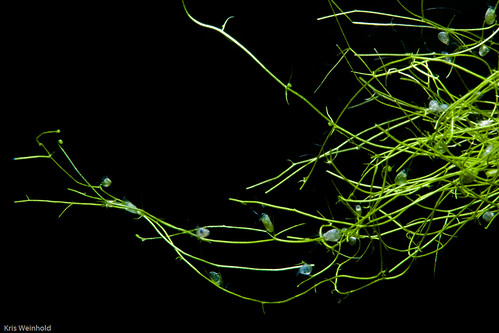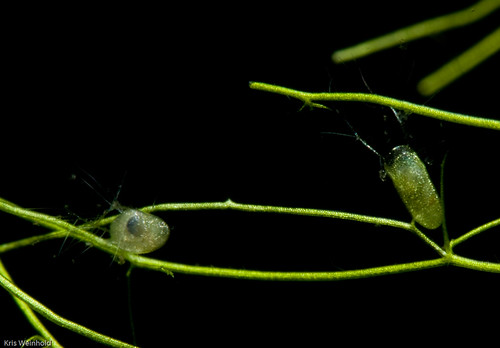Utricularia gibba
December 10th, 2008I was first introduced to Utricularia gibba at a GWAPA meeting when another member asked the host for a pair of tweezers, and promptly began to remove a few strands from their tank. Utricularia gibba is often mistaken for algae due to its similar appearance, but it is actually a carnivorous plant that survives by trapping tiny microorganisms in its bladders. At least, if you have ever had an algae outbreak, you could take solace that with proper attention, the tank could relatively easily be made algae-free. Unfortunately, if you find Utricularia gibba in your tank, you’re not so fortunate.
This plant thrives in the same conditions that your other plants do, so your only recourse is to manually remove thread after thread with a pair of tweezers. The most common way that a tank becomes infected is when Utricularia gibba hitch-hikes on some other plant that you introduce into your aquarium.
From there, it’s just a matter of time before the bladder-ridden threads wind themselves in amongst the stems of your beautiful plants. You may actually wish to have this plant in outdoor water gardens, however, as Utricularia gibba does produce a pretty yellow flower above the surface.
Fortunately, I’ve never had a huge problem with this plant. I’ve introduced it to a couple of my tanks in the past, but luckily was able to contain and rectify the situation shortly thereafter. So, keep an eye out for Utricularia gibba whenever you add new plants to your aquarium.



December 10th, 2008 at 6:46 am
I’ve kept it a few times and apart from the attractive flowers it has a most interesting biology, particularly if you have a microscope.
December 10th, 2008 at 6:50 am
Phillip, care to elaborate a little bit more? With a microscope, are you able to see the trapped microorganisms?
December 10th, 2008 at 9:17 am
I was thinking of both my own days of doing A Level biology and the following links:
http://growingpassion.blogspot.com/2008/03/utricularia-gibba.html
http://en.wikipedia.org/wiki/Utricularia
(trapping mechanism section)
I keep meaning to buy a microscope again as it truly opens up a new world.
December 10th, 2008 at 3:54 pm
I’ve actually been hoping to add bladderworts to my carnivore collection. Let me know if you need to clean out a tank again. ;D
December 10th, 2008 at 5:40 pm
Not only do you have great activities to attend, you have a *basement*. What I’d give for a basement!
And I’ll take some of that Utricularia gibba stuff, too:) Would be nice in my little 2.5 gallon.
December 11th, 2008 at 11:43 am
The tadpoles of the green paddy frog, sometimes referred to in the trade as the striped rice paddy frog, and scientifically known as Rana erythrea, are reportedly “associated with Utricularia sp.” – I don’t know if this means that they actually eat the stuff, or if they just hang out in it (the scientists themselves are probably still trying to figure that one out!). Of course, if they eat it, they could theoretically be used to control it in aquariums – provided you don’t keep fish species which like to prey on tadpoles!
In any event, Rana erythrea is probably the most beautiful little ranid frog I’ve ever seen for sale in the hobby … while it’s a fairly common and widely-distributed species in Southeast Asia, it rarely shows up in the trade, and it’s occurred to me that one might be able to breed it in captivity, in a very large paludarium with lots of Utricularia in the water portion. Just an idea – I personally don’t have the time or resources to pursue such a project, but maybe some reader out there does!
To see a good photo of Rana erythrea, check out Berkley University’s amphibian conservation web site, Amphibiaweb.org. (That’s where I got the info about the “association” between the two species)
December 11th, 2008 at 2:47 pm
My favorite carnivorous plant dealer – Sarracenia Northwest – had a bunch of their bladderworts eaten by tadpoles this last growing season.
December 11th, 2008 at 2:59 pm
Heh, I think ya’ll missed that beyond it’s carnivorous lure, I hate this plant, as far as it’s aquarium use. In fact, for these pictures, I had to ask to borrow another GWAPA member’s plants to take the picture, so I don’t have any to share, unfortunately. 🙁
That’s an interesting relationship Mark. I guess OG confirms that tadpoles are a threat to eat the stuff, which means they could be useful in an aquarium, so long as they *only* eat the Utricularia, and not the other plants.
OG, have you ever dealt with this CP nursery?
http://www.carnivorousplantnursery.com
They’re local, and the owner is a really nice guy.
December 11th, 2008 at 3:16 pm
I haven’t ordered anything off of there, no. I think I stumbled onto his site before, but SNW was highly reccommended by a friend of mine so I went with them. But I love buying locally, especially for plants adapted to local conditions, so I’ll have to peruse more closely, especially since I’ve got a spot in my front garden all ready for more carnivores this spring.
I guess I didn’t gather from your post how much you hated it. I take it that it’s really invasive. Does it choke out other plants as well?
December 11th, 2008 at 6:25 pm
I wouldn’t say that it chokes other plants out, but just like hair/thread algae, it’s an eye sore that’s especially hard to get rid of.
December 12th, 2008 at 11:25 am
Concerning the use of tadpoles as Utricularia control in a planted aquarium, I’d guess that the same rule applies to them as to herbivorous fish such as Metynnis: they can only be kept in tanks where the plantings are limited to firm, bitter-tasting, broad-leaf plants, such as anubias, java ferns, maybe jungle vals, etc. – provide them with more desirable foods (soft algae, cooked spinach, etc.), and you should be okay. Bear in mind, though, that many native tadpoles – some of which hatch in early Spring, in cool vernal pools – probably can’t take the heat in tropical aquariums.
When I think about it, it makes perfect sense that tadpoles would like Utricularia: we’re talking about an animal (frogs) whose larval stage is herbivorous, but then becomes a carnivore as an adult – maybe eating carnivorous plants is a way for the tadpole to prepare its digestive system for animal protiens.
December 13th, 2008 at 12:02 am
Great thoughts about the tadpoles Mark! Please let us know if you’re ever able to test out these theories.
April 14th, 2011 at 2:47 am
U. gibba can be quite good looking in a planted tank. As an example, in Takashi Amano’s Nature Aquarium World, Book 2, on page 56: “Underwater Flamenco” aquarium uses it very heavily in the foreground.